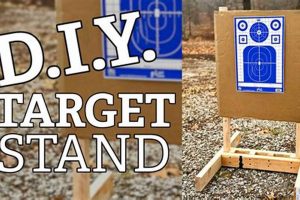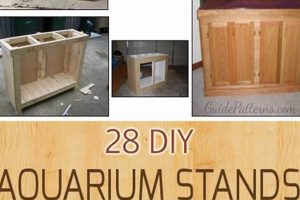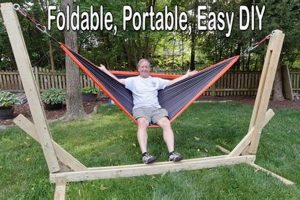The creation of a custom support structure for photographic or video backdrops, achieved through self-directed construction methods, allows for tailored solutions in visual media production. For instance, using readily available materials like PVC pipes and connectors, an individual can assemble a framework to hold fabric or paper backdrops for portrait photography.
Constructing supports in this manner offers several advantages. It provides a cost-effective alternative to purchasing pre-made systems, enabling budget-conscious creators to achieve professional results. Furthermore, it allows for customization in terms of size, portability, and material selection, adapting to specific project requirements. Historically, individuals have relied on ingenuity and resourcefulness to fashion similar supports, demonstrating a continued demand for adaptable solutions in content creation.
This approach necessitates a comprehensive understanding of material properties, structural design principles, and safe assembly techniques. The subsequent sections will delve into various construction methodologies, material options, and safety considerations pertinent to building a custom backdrop support system.
Construction Guidance
The following recommendations aim to enhance the effectiveness and safety of self-fabricated background support systems.
Tip 1: Material Selection. Prioritize robust and dimensionally stable materials. PVC pipes, metal tubing, or wooden framing provide structural integrity. Consider the weight of the backdrop material when choosing the load-bearing components.
Tip 2: Stability Enhancement. Employ wide-based supports or sandbags to augment stability, particularly when using lightweight materials. This prevents accidental toppling during usage.
Tip 3: Connection Security. Ensure secure connections between structural elements. Use appropriate adhesives, screws, or clamping mechanisms to prevent joint failure.
Tip 4: Adjustable Height Mechanism. Integrate an adjustable height mechanism for adaptability. Telescoping poles or sliding brackets allow for fine-tuning backdrop placement.
Tip 5: Portability Considerations. Design the support for easy disassembly and transport if mobility is a requirement. Modular designs facilitate compact storage and relocation.
Tip 6: Backdrop Attachment Method. Implement a reliable backdrop attachment method. Clamps, clips, or sewn sleeves secure the backdrop without causing damage.
Tip 7: Safety Inspection. Conduct a thorough safety inspection prior to each use. Check for loose connections, material fatigue, and overall structural integrity.
Adherence to these guidelines promotes a stable, adaptable, and safe system for supporting backdrops, thus enhancing the quality and efficiency of visual media production.
The subsequent conclusion will summarize the key aspects of creating a custom background support and its implications.
1. Material Strength
Material strength is a fundamental consideration in the context of constructing a customized backdrop support. The inherent ability of the chosen materials to withstand stress and strain directly correlates with the stability and longevity of the support structure. Inferior material strength can lead to structural failure, potentially causing damage to equipment or injury to personnel. For example, using thin-walled PVC piping for a large backdrop can result in bowing or collapse under the weight of the fabric, necessitating a more robust material like steel or a higher grade of PVC.
The selection of materials for elements such as the uprights, crossbars, and base components is critical. Consider a comparison: aluminum, while lightweight, may not provide sufficient rigidity for holding heavier backdrops, making steel a more appropriate choice despite its increased weight. Wood, another option, offers adequate strength but may be susceptible to warping or moisture damage if not properly treated. The design of the joints and connections is equally important, as weak connections can become points of failure, irrespective of the overall material strength. Properly implemented welding, bolting, or adhesive bonding methods can enhance the load-bearing capacity of the assembled structure.
In conclusion, achieving a safe and reliable backdrop support mandates a thorough evaluation of material strength. Selecting materials that meet or exceed the anticipated load requirements, coupled with sound engineering principles in the construction process, ensures a stable platform for professional or amateur photographic and video endeavors. Addressing the limitations of chosen materials through appropriate design modifications or reinforcement techniques remains paramount to preventing structural compromise and ensuring safe operation.
2. Structural Stability
Structural stability represents a crucial consideration in the self-directed construction of background support systems. The ability of the structure to withstand applied loads and maintain its intended geometry is paramount to ensuring safety and functionality.
- Base Support and Weight Distribution
The base of the support system dictates its ability to resist overturning moments. A wider base distributes the load over a larger area, increasing stability. For example, a tripod base provides greater inherent stability compared to a single vertical support. The placement of weights, such as sandbags, near the base further lowers the center of gravity and enhances resistance to tipping.
- Material Rigidity and Joint Integrity
Material selection influences overall rigidity. Materials with a high modulus of elasticity, such as steel, resist bending and deformation under load. However, the integrity of the joints connecting these materials is equally critical. Weak or improperly fastened joints can become points of failure, negating the benefits of robust materials. Screws, bolts, or welded connections should be appropriately sized and spaced to ensure adequate shear and tensile strength.
- Cross-Bracing and Support Geometry
Incorporating cross-bracing elements enhances stability by distributing loads across multiple structural members. Triangulated designs, commonly employed in bridge construction, are inherently stable due to their ability to resist deformation. Similarly, angled supports or struts can provide lateral stability, preventing swaying or collapse under wind loads or uneven weight distribution of the backdrop material.
- Load Capacity and Safety Factors
The system’s maximum load capacity must be determined to prevent overloading. This entails calculating the weight of the backdrop material, including any additional accessories, and comparing it to the support structure’s rated load capacity. A safety factor should be applied to account for unforeseen loads or material imperfections. Failure to consider load capacity can result in structural failure and potential hazards.
In summary, structural stability is not solely determined by a single factor but rather by a combination of design elements and material properties. The self-directed construction of backdrop supports requires a thorough understanding of these principles to ensure a safe, reliable, and functional system for supporting photographic or video backdrops.
3. Portability
The dimension of portability exerts a considerable influence on the design and execution of a custom backdrop support. The ease with which a support structure can be transported and reassembled directly affects its utility across diverse shooting locations. A non-portable support, while potentially robust, limits its applicability to fixed studio environments, negating its value in field photography or videography. The self-directed creation of such supports often prioritizes modular designs and lightweight materials to facilitate transport. Examples include using aluminum tubing instead of steel, or designing a system that disassembles into easily manageable components. This consideration is paramount for photographers and videographers who frequently operate in variable or remote environments.
The impact of portability manifests in various design choices. Collapsible tripod bases, sectional crossbars, and compact storage solutions directly address the logistical challenges of transporting bulky equipment. Moreover, the selection of materials and connection methods must balance strength and weight. The common usage of PVC piping, while economical and lightweight, necessitates careful consideration of its load-bearing capacity. The use of interlocking connectors and tool-free assembly mechanisms further enhances portability by reducing setup time and complexity. The demand for highly portable backdrop systems has spurred innovations in materials science and structural engineering, yielding designs that minimize weight while maintaining structural integrity.
In summary, portability represents a significant design parameter in the construction of background support systems. It directly influences material selection, structural design, and assembly methods. The capacity to efficiently transport and deploy a backdrop support significantly expands its utility, making it a critical consideration for visual media professionals and hobbyists alike. The inherent trade-offs between portability, stability, and load capacity require careful analysis and informed decision-making during the construction process.
4. Cost Effectiveness
The pursuit of cost-effectiveness is a primary driver in the decision to undertake background support construction. Purchasing pre-fabricated systems often represents a significant capital outlay, particularly for advanced features or larger dimensions. Constructing a support structure provides a viable alternative, potentially reducing expenses through the utilization of readily available and inexpensive materials, such as PVC piping or repurposed lumber. The economic advantage arises from eliminating manufacturing overhead, distribution costs, and retail markups. A typical example involves building a basic frame from PVC pipes and fittings, costing significantly less than an equivalent commercially produced stand.
Material choices heavily influence the overall cost. Opting for alternative materials can substantially reduce expenses. For instance, substituting metal supports with wooden frames or employing recycled materials contributes to overall cost reduction. The design itself plays a pivotal role, with simpler designs requiring less material and labor. A straightforward rectangular frame, for instance, is significantly more cost-effective to build than a complex adjustable system. Furthermore, the longevity of the system affects long-term cost-effectiveness. Utilizing durable materials and robust construction techniques minimizes the need for repairs or replacements, thereby extending the life cycle and reducing overall expenses.
In summary, the economic benefits are a compelling factor in opting for a self-made background support. By judiciously selecting materials, employing simple designs, and prioritizing durability, significant cost savings can be realized. This approach provides a viable solution for individuals and organizations seeking to manage expenses while achieving professional results in visual media production. However, the trade-off between cost and features must be carefully considered to ensure that the constructed support meets the specific requirements of the application.
5. Size Customization
Size customization is a fundamental advantage inherent in self-directed background support construction. Commercial systems often present limitations in dimensions, failing to accommodate specific project requirements or studio constraints. The ability to tailor the support structure to precise dimensions directly influences its functionality and adaptability. This capability permits the creation of supports suitable for various backdrop sizes, aspect ratios, and spatial configurations, allowing for greater creative control and operational efficiency. For instance, a photographer requiring a panoramic backdrop would necessitate a wider-than-standard support, achievable through custom construction.
The importance of size customization extends to practical applications across diverse visual media production scenarios. Portrait photography may demand a compact, easily adjustable support, while large-scale video productions necessitate wider and taller structures. The ability to precisely control the dimensions of the support minimizes wasted space, improves backdrop tensioning, and reduces potential issues related to lighting and shadow casting. Moreover, custom dimensions facilitate integration within pre-existing studio spaces, adapting to architectural constraints and optimizing workflow. The construction of supports with adjustable height and width further expands the range of potential applications, ensuring compatibility with a variety of backdrop materials and shooting angles.
The freedom to modify dimensions allows for the creation of support systems perfectly tailored to a specific use case, which directly contributes to cost-effectiveness. Understanding this connection is key to leveraging the full potential of self-directed construction, resulting in a background support that effectively and efficiently meets the unique needs of the visual media creator. This contrasts with pre-fabricated systems, which require either accepting the offered dimensions or incurring further expenses on modifications. Thus, the direct influence on practicality and economics makes size customization a highly significant aspect of custom background support creation.
6. Ease of Assembly
The constructability of a support structure directly impacts its adoption and utility. Intricate designs or complex assembly procedures impede practical application, especially in time-sensitive environments. The ease with which a support can be erected and dismantled determines its effectiveness in on-location shoots or studio setups requiring frequent reconfiguration. A design characterized by minimal components, intuitive connections, and tool-free assembly maximizes efficiency and reduces potential errors. For instance, a system utilizing snap-fit connectors requires less time and skill to assemble compared to one requiring bolted joints and specialized tools. The correlation between constructability and usability cannot be overstated.
Reduced assembly time translates to increased productivity, allowing photographers and videographers to focus on creative aspects rather than logistical challenges. A user-friendly design minimizes the learning curve, enabling individuals with varying levels of technical expertise to effectively deploy the support. This accessibility is particularly relevant for independent content creators or educational institutions where resource constraints may limit access to skilled personnel. Furthermore, simple assembly procedures reduce the risk of damage to components during handling, extending the lifespan of the support. A modular system with clearly labeled parts and intuitive connections ensures rapid deployment and minimizes the potential for user error.
In conclusion, a design prioritizing ease of assembly is fundamental to maximizing the utility and accessibility of a self-made backdrop support. This consideration directly influences its practical application across diverse production environments and user skill levels. Prioritizing simplicity in construction is not merely a convenience; it is a critical factor in optimizing efficiency, minimizing errors, and extending the lifespan of the support system. Therefore, a thoughtful design that prioritizes simple assembly is crucial for any self-directed construction of a backdrop support.
Frequently Asked Questions
The following section addresses common inquiries and concerns regarding the self-directed construction of background support systems.
Question 1: What material is optimal for self-constructed background support systems?
The selection of materials depends on specific needs and budget. PVC piping offers a cost-effective and lightweight option for smaller backdrops. Metal tubing, such as steel or aluminum, provides increased strength and stability for larger or heavier backdrops. Wood can be employed, but requires proper treatment to prevent warping or moisture damage.
Question 2: How can stability be ensured in a background support?
Stability is achieved through a wide base, proper weight distribution, and secure connections. Employing tripods or weighted bases enhances stability. Cross-bracing and robust joints are also critical to prevent swaying or collapse.
Question 3: Is portability feasible in a self-constructed support?
Portability can be achieved through modular designs and the selection of lightweight materials. Sectional poles and collapsible bases facilitate transport and storage. Aluminum, rather than steel, reduces the overall weight of the system.
Question 4: What is the recommended method for attaching a backdrop to the support?
Backdrops can be attached using clamps, clips, or sewn sleeves. Clamps provide a versatile and adjustable attachment method. Sewn sleeves allow for seamless integration, but require more preparation.
Question 5: How can adjustable height be incorporated into a self-constructed support?
Adjustable height can be integrated using telescoping poles or sliding brackets. These mechanisms allow for fine-tuning the backdrop placement. Secure locking mechanisms are essential to prevent slippage.
Question 6: What safety precautions should be taken during construction and use?
Eye protection and appropriate gloves should be worn during construction. All connections should be thoroughly inspected before each use. The support’s load capacity should not be exceeded, and weights should be added to enhance stability.
In summary, the self-directed construction of background supports requires careful planning, material selection, and adherence to safety guidelines. These FAQs offer a foundation for addressing common concerns and ensuring a successful outcome.
The subsequent section explores case studies illustrating successful and unsuccessful approaches to self-directed background support construction.
Conclusion
The preceding exploration of “backdrop stand diy” has underscored its potential as a cost-effective, customizable, and adaptable solution for visual media production. Essential elements such as material strength, structural stability, portability, cost-effectiveness, size customization, and ease of assembly exert a profound influence on the functionality and safety of the resultant support system. A comprehensive understanding of these factors, coupled with adherence to established construction principles, is paramount to achieving a successful outcome.
The decision to engage in the self-directed creation of a backdrop support necessitates a careful evaluation of project requirements and resource constraints. While “backdrop stand diy” offers numerous advantages, it also demands a commitment to meticulous planning, precise execution, and unwavering adherence to safety protocols. Continued innovation in materials science and structural engineering will undoubtedly further enhance the accessibility and effectiveness of “backdrop stand diy” in the evolving landscape of visual media creation. The successful implementation of these principles will ensure a safe and effective background support system.





![Build a Better DIY Table Saw Stand [Plans & Guide] The DIY Hub: Creative Crafts, Repairs & Life Hacks Build a Better DIY Table Saw Stand [Plans & Guide] | The DIY Hub: Creative Crafts, Repairs & Life Hacks](https://craftingdiycenter.com/wp-content/uploads/2025/07/th-3315-300x200.jpg)

